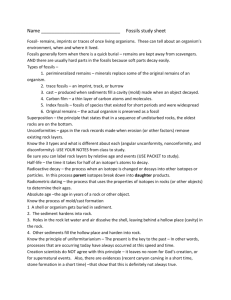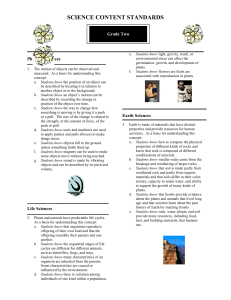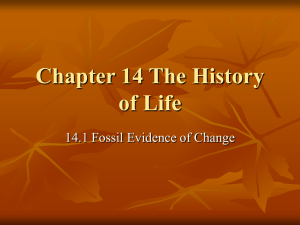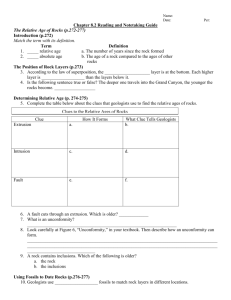Lesson 1
advertisement
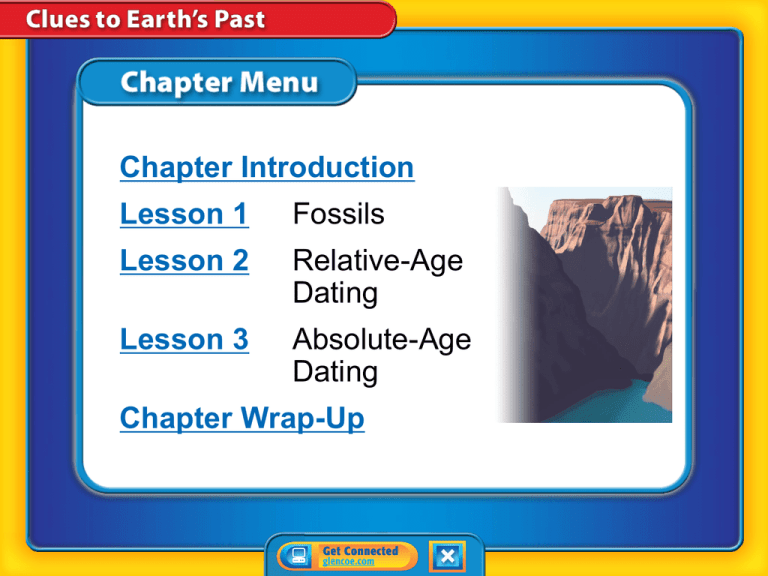
Chapter Introduction Lesson 1 Fossils Lesson 2 Relative-Age Dating Lesson 3 Absolute-Age Dating Chapter Wrap-Up What evidence do scientists use to determine the ages of rocks? What do you think? Before you begin, decide if you agree or disagree with each of these statements. As you view this presentation, see if you change your mind about any of the statements. Do you agree or disagree? 1. Fossils are pieces of dead organisms. 2. Only bones can become fossils. 3. Older rocks are always located below younger rocks. Do you agree or disagree? 4. Relative age means that scientists are relatively sure of the age. 5. Absolute age means that scientists are sure of the age. 6. Scientists use radioactive decay to determine the ages of some rocks. Fossils • What are fossils and how do they form? • What can fossils reveal about Earth’s past? Fossils • fossil • mold • catastrophism • cast • uniformitarianism • trace fossil • carbon film • paleontologist Evidence of the Distant Past • Fossils are the preserved remains or evidence of ancient living things. • Fossils are some of the most obvious clues for understanding Earth’s past. fossil from Latin fossilis, means “dug up” Evidence of the Distant Past (cont.) • Catastrophism is the idea that conditions and creatures on Earth change in quick, violent events. • Some early scientists explained Earth’s history as a series of disastrous events occurring over short periods of time. Evidence of the Distant Past (cont.) • James Hutton thought that the processes responsible for changing the landscape on his farm could also shape Earth’s surface. • Hutton’s ideas were included in a principle called uniformitarianism, which states that geologic processes that occur today are similar to those that have occurred in the past. Evidence of the Distant Past (cont.) • According to uniformitarianism, Earth’s surface is constantly being reshaped in a steady, uniform manner. • Scientists know that catastrophic events, which can be explained by natural processes, do sometimes occur. Formation of Fossils • Some conditions increase the chances of fossil formation. • An organism is more likely to become a fossil if it has hard parts—such as shells, teeth, or bones—that do not decay easily. An organism is more likely to form a fossil if it is buried quickly after it dies because layers of sand or mud slow decay. Formation of Fossils (cont.) • Not all fossils are large enough to see without a microscope. • Tiny fossils are called microfossils. Formation of Fossils (cont.) What conditions increase the chances of fossil formation? Types of Preservation • Sometimes the actual remains of organisms are preserved as fossils. • For this to happen, an organism must be completely enclosed in some material over a long period of time to prevent it from being exposed to air or bacteria. Types of Preservation (cont.) • Sometimes when an organism is buried, pressure on the organism is so great that it drives off the gases and liquids from an organism’s tissues, leaving only the carbon behind. • A carbon film is the fossilized carbon outline of an organism or part of an organism. Types of Preservation (cont.) • Replicas, or copies, of organisms can form when the minerals in groundwater fill in the pore spaces or replace the tissues of dead organisms. • This tree has had the tissues in it replaced by minerals, becoming petrified. Scientifica/Getty Images Types of Preservation (cont.) petrified Science Use turned into stone by the replacement of tissues with minerals Common Use made rigid with fear Types of Preservation (cont.) • A mold is the impression in a rock left by an ancient organism. • A mold can form when sediment hardens around a buried organism, making an impression in the shape of the organism. • A cast is a fossil copy of an organism made when a mold of the organism is filled with sediment or mineral deposits. Types of Preservation (cont.) • A trace fossil is the preserved evidence of the activity of an organism. • Trace fossils include tracks, footprints, and nests and help scientists learn about characteristics and behaviors of animals. Ancient Environments • Scientists who study fossils are called paleontologists. • Paleontologists use the principle of uniformitarianism to learn about ancient organisms and the environments in which they lived. Ancient Environments (cont.) Studying fossils helped scientists reconstruct this 450-million-year-old North American seafloor. Most of what would become the United States was covered by a shallow sea during that time. Ancient Environments (cont.) What can fossils tell us about ancient environments? Ancient Environments (cont.) • Fossils also show that Earth’s climate has warmed and cooled many times in the past. • Plant fossils are especially good indicators of climate change. Ancient Environments (cont.) • Fossils of some plants reveal that 100 million years ago, Earth was very warm and covered by tropical forests and swamps. • Fossils of some organisms, like ferns and woolly mammoths, help scientists learn about ancient organisms and past environments. Ancient Environments (cont.) What was Earth’s climate like when dinosaurs lived? • The principle of uniformitarianism is the basis for understanding Earth’s past. • Fossils can form in many different ways. • Fossils help scientists learn about Earth’s ancient organisms and past environments. Scientifica/Getty Images What is a fossilized outline of an organism or part of an organism called? A. carbon film B. cast C. mold D. trace fossil Which term describes the preserved evidence of the activity of an organism? A. cast B. trace fossil C. mold D. carbon film Which principle states that geologic processes that occur today are similar to those that have occurred in the past? A. catastrophism B. uniformitarianism C. paleontology D. geology Do you agree or disagree? 1. Fossils are pieces of dead organisms. 2. Only bones can become fossils. Relative-Age Dating • What does relative age mean? • How can the positions of rock layers be used to determine the relative ages of rocks? Relative-Age Dating • relative age • correlation • superposition • index fossil • inclusion • unconformity I. Relative Ages of Rocks A. Relative age is the age of rocks and geologic features compared with other rocks and features nearby. B. Superposition is the principle that says in undisturbed rock layers, the oldest rocks are on the bottom, youngest on top. 1. Unless some force disturbs the layers after they were deposited I. Relative Ages of Rocks (cont.) How might you define your relative age? I. Relative Ages of Rocks (cont.) C. Principle of original horizontality- most rock-forming materials are deposited in horizontal layers. 1. Even if rock layers are tilted from being disturbed or deformed, all the layers were originally deposited horizontally. I. Relative Ages of Rocks (cont.) D. The principle of lateral continuitySediments are deposited in large, continuous sheets in all lateral directions. 1. The sheets, or layers, continue until they thin out or meet a barrier. I. Relative Ages of Rocks (cont.) lateral from Latin lateralis, means “belonging to the side” E. Geologic principles help scientists determine the relative order of rock layers. I. Relative Ages of Rocks (cont.) F. Inclusion- A piece of an older rock that becomes part of a new rock. 1. According to the principle of inclusions, if one rock contains pieces of another rock, the rock containing the pieces is younger than the pieces. 2. The principle of cross-cutting relationships says that if one geologic feature cuts across another feature, the feature that it cuts across is older. I. Relative Ages of Rocks (cont.) What geologic principles are used in relative-age dating? II. Unconformities A. Unconformity- A surface where rock has eroded away, producing a break, or gap, in the rock record. 1. Younger rocks have been deposited on a layer of eroded rocks were. 2. An unconformity does not represent a gap in the rock; it represents a gap in time. Draw these in your notes! II. Unconformities (cont.) How does an unconformity represent a gap in time? III. Correlation A. Correlation- Matching rocks and fossils from separate locations. 1. Geologists use correlation to fill in gaps in the rock record. 2. Sometimes it is possible to connect rock layers simply by walking along rock formations and looking for similarities. B. Geologists use correlation to established a historical record. III. Correlation (cont.) C. Index fossils represent species that existed on Earth for a short length of time, were abundant, and inhabited many locations. 1. Index fossils found at different locations, can usually indicate that the layers are of similar age. Correlation (cont.) How are index fossils useful in relative-age dating? • Geologic principles help geologists learn the relative ages of rock layers. • The rock record is incomplete because some of it has eroded away. • Geologists fill in gaps in the rock record by correlating rock layers. Which of these refers to the dating of rocks and geologic features by comparing them to other rock and features nearby? A. superposition B. relative age C. lateral continuity D. unconformity Which object represents species that existed on Earth for a short length of time, were abundant, and inhabited many locations? A. trace fossils B. index fossils C. molds D. casts Which principle says that in undisturbed rock layers, the oldest rocks are on the bottom? A. inclusion B. relative age C. unconformity D. superposition Do you agree or disagree? 3. Older rocks are always located below younger rocks. 4. Relative age means that scientists are relatively sure of the age. Absolute-Age Dating • What does absolute age mean? • How can radioactive decay be used to date rocks? Absolute-Age Dating • absolute age • isotope • radioactive decay • half-life IV. Absolute Ages of Rocks A. Absolute age refers to the numerical age, in years, of a rock or object. 1. Helps develop accurate historical records from many geologic formations. 2. Used since the 20th century, when radioactivity was discovered. Absolute Ages of Rocks (cont.) How is absolute age different from relative age? V. Elements, Atoms & Radioactivity A. All atoms of a given element have the same number of protons. B. Isotopes are atoms of the same element that have different numbers of neutrons. C. Radioactive decay is the process by which an unstable element naturally changes into another element that is stable (the release of energy from unstable atoms). . Atoms (cont.) 1. The rate of decay is constant for a given isotope and measured in time units called half-lives. 2. Half-life- is the time required for half of the parent isotopes to decay into daughter isotopes. a. Half-lifes range from a few microseconds to billions of years. VI. Radiometric Ages A.Because radioactive isotopes decay at a constant rate, they can be used to measure the age of the material that contains them. B. Radiometric dating is the process in which scientists measure the ratio of the amount of parent isotope to daughter product Radiometric Ages (cont.) C. Radiocarbon, or C-14, is often used in radiometric dating. 1.Forms in the upper atmosphere, where it mixes with carbon-12, or C-12. 2. The ratio of C-14 to C-12 in its tissues is identical to the ratio in the atmosphere when the organism is alive Radiometric Ages (cont.) 3. When an organism dies, it stops taking in C-14 and the ratio of C-14 to C-12 changes a. Scientist use this ratio to determine how old the fossil is b. C-14’s half-life is about 5730 years 4. Useful for measuring the age of the remains that died up to about 50,000 years ago. D. The ratio of U-235 to Pb-207 in a mineral VI. Radiometric Ages (cont.) E. Uranium-235, or U-235, is often trapped in the minerals of igneous rocks 1. The half-life of uranium-235 is 704 million years 2. Useful for dating rocks that are very old. VI. Radiometric Ages (cont.) F. The grains in many sedimentary rocks come from a variety of weathered rocks from different locations. 1. Isotopes in these grains not very useful for dating b/c it records the age of the grains, not when deposited. Radiometric Ages (cont.) Why are radioactive isotopes not useful for dating sedimentary rock? G. For dating rocks that do not include organic material, geologists used different kinds of radioactive isotopes. VI. Radiometric Ages (cont.) Why is a radioactive isotope with a long half-life used in dating very old rocks? VI. Radiometric Ages (cont.) H. The oldest known rock is estimated to be between 4.03 billion and 4.28 billion years old. 1. This is how the age of the Earth was estimated. 2. Radiometric dating of rocks from the Moon and meteorites indicate that Earth is 4.54 billion years old. • When the unstable atoms of radioactive isotopes decay, they form new, stable isotopes. • Because radioactive isotopes decay at constant rates, they can be used to determine absolute ages. • Isotopes with long half-lives are the most useful for dating old rocks. Radioactive decay is the process by which an unstable element naturally changes into which of these? A. an isotope B. a neutron C. a stable element D. a proton Which of these refers to the time required for half of the parent isotopes to decay into daughter isotopes? A. age B. radiometric date C. rate of decay D. half-life Isotopes are atoms of the same element that have different numbers of what? A. neutrons B. atoms C. protons D. parent isotopes Do you agree or disagree? 5. Absolute age means that scientists are sure of the age. 6. Scientists use radioactive decay to determine the ages of some rocks. Key Concept Summary Interactive Concept Map Chapter Review Standardized Test Practice Evidence from fossils, rock layers, and radioactivity help scientists understand Earth’s history and determine the ages of Earth’s rocks. Lesson 1: Fossils • The principle that Earth processes occurring today are similar to those that occurred in Earth’s past is called uniformitarianism. • Dead organism are more likely to become fossils if they have hard parts and are buried quickly after they die. • Fossils include carbon films, mold, casts, and trace fossils. • Paleontologists use clues from fossils to learn about ancient life and the environments ancient organisms lived in. Scientifica/Getty Images Lesson 2: Relative-Age Dating • The relative age of rock layers can be determined using geologic principles, such as the principle of superposition and the principle of inclusion. • Unconformities represent time gaps in the rock record. • Because the rock record is incomplete, geologists use correlation to match rock layers. • Index fossils are especially useful in correlating rock layers that are geographically far apart. Lesson 3: Absolute-Age Dating • Absolute age is the age in years of a rock or object. • The radioactive decay of unstable isotopes occurs at a constant rate, measured as half-life. • To date a rock or object, scientists measure the ratios of its parent and daughter isotopes. Which of these refers to the idea that conditions and creatures on Earth change in quick, violent events? A. preservation B. catastrophism C. fossilization D. uniformitarianism An organism is more likely to become a fossil if it has which of these? A. hard parts B. soft tissue C. small parts D. fur Which of these refers to a surface where rock has eroded away, producing a gap in the rock record? A. correlation B. an index fossil C. inclusion D. unconformity When an index fossil is found in rock layers at different locations, what can geologists infer about the layers? A. they are much older B. they are much younger C. they are of similar age D. they are exactly the same age What are atoms of the same element that have different numbers of neutrons? A. isotopes B. protons C. half-lives D. elements Which term refers to the preserved remains or evidence of ancient living things? A. rocks B. minerals C. fossils D. shells Which of these is the impression in a rock left by an ancient organism? A. fossil B. carbon film C. cast D. mold What term describes matching rocks and fossils from separate locations? A. correlation B. unconformity C. comparison D. inclusion During which process does an unstable element naturally change into another element that is stable? A. radiometric dating B. absolute aging C. radioactive decay D. radiometric aging Of which of the following do all atoms of a given element have the same number? A. neutrons B. isotopes C. parent isotopes D. protons

